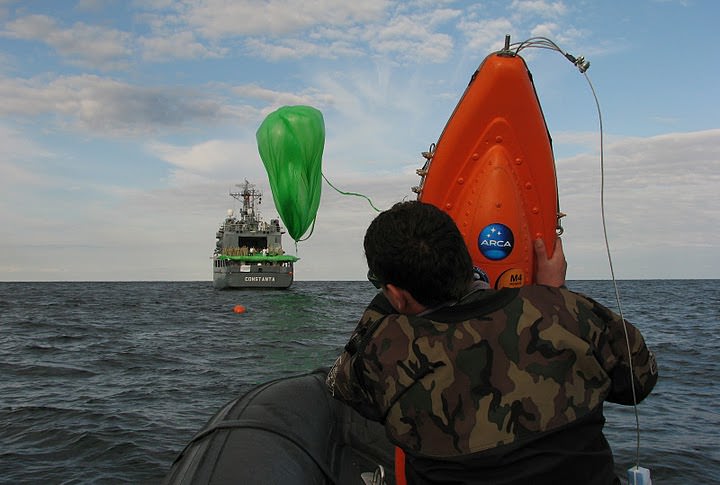[/caption]
A Romanian team aiming to send a rocket to the Moon via balloon successfully launched a test flight of their Helen 2 rocket, sending the first Romanian-made rocket system to 40,000 meters above the Earth. The Aeronautics and Cosmonautics Romanian Association (ARCA) team is vying for the
Google Lunar X PRIZE,
and tested the balloon/rocket system (sometimes called a 'rockoon') which launched from a Romanian naval frigate from the Black Sea. While the balloon and rocket worked great, the parachute and recovery system failed. But the team met their main objectives and were ecstatic.
[caption id="attachment_75000" align="aligncenter" width="580" caption="A Romanian naval officer celebrates with a member of the ARCA team after the rocket fired successfully. Credit: ARCA"]
[/caption]
ARCA has a simple, "green" design. For getting the Moon, a super-huge balloon will carry a system of three rockets to about 18 km (11 miles). Then the first two rocket stages will fire and boost the system into low Earth orbit, and use the final stage to boost it to the Moon. The lander, the European Lunar Explorer (ELE) resembles a knobby rubber ball that uses its own rocket engine to ensure a soft landing. They consider their system to be green, as the rocket engine operates exclusively with hydrogen peroxide
[caption id="attachment_75001" align="aligncenter" width="580" caption="The Helen rocket is lifted into the air by the balloon. Credit: ARCA"]
[/caption]
The balloon ascent took 40 minutes, bringing the system to an altitude of 14,000 m, at times raising the system at 120 km/h. When it reached that altitude, the flight controllers on the naval ship lit the rocket engines for 30 seconds, bringing it to 40,000 meters. From flight data transmitted to the control centers of ARCA and the Romanian civil aviation authority (ROMATSA) the team was able to confirm the successful flight trajectory, which had an error of only 800 m from the center of their safe trajectory.
A payload on board the capsule took pictures from the top of the trajectory.
[caption id="attachment_75002" align="aligncenter" width="580" caption="An image sent down from the capsule from about 40,000 meters. Credit: ARCA"]
[/caption]
But at the capsule's reentry, the parachute did not open, and a ship sent to try and find the capsule in the water was not able to find and retrieve it. But the ARCA team said they didn't look for it for very long, since most data were transmitted by radio telemetry and satellite and recovery isn't an objective of the Google Lunar X Prize Competition.
However, they were able to complete the successful launch of the first Romanian space rocket, as well as their first flight of the Google Lunar X Prize Competition. They also verified their rocket stabilization system, and reached the highest altitude ever by an object designed and built entirely in Romania.
In November 2009, ARCA's test flight hopes were dashed when the
balloon's lines became entangled during inflation and had to be cut, and the test curtailed.
Rockoons were tried and then abandoned by the US in the 1950s because they blew off course in windy conditions.
Watch a video animation of the test flight:
See more images of the test flight at
ARCA's Picasa page.
Source: ARCA
 Universe Today
Universe Today
